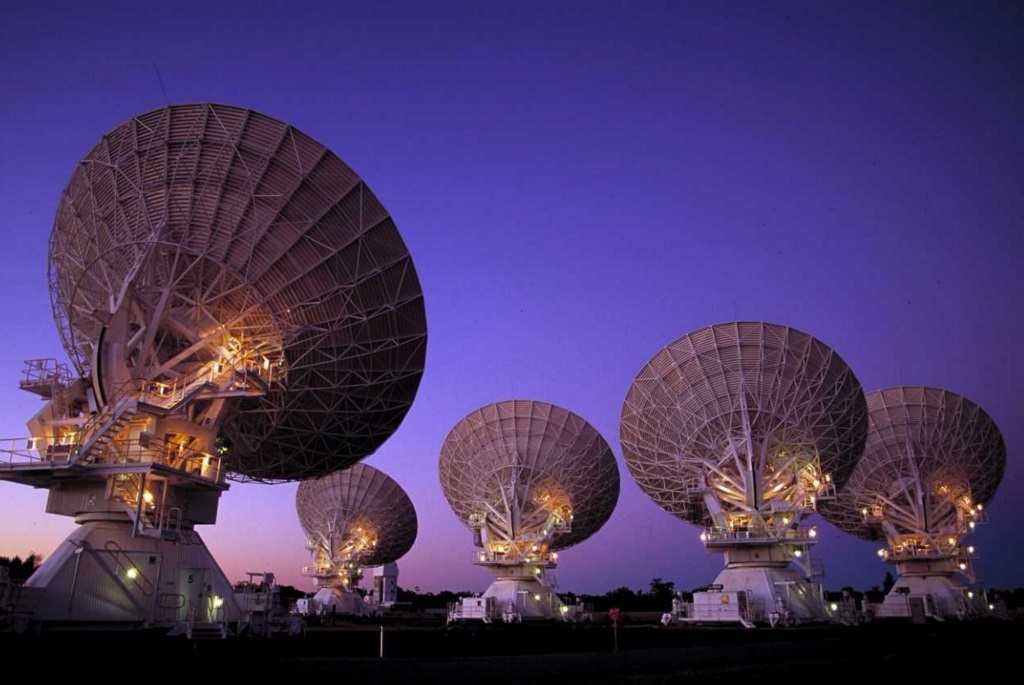6 FEBRUARY 2018
Significant benefits for radio astronomy could be derived from instrumentation developed by a national consortium involving Macquarie University researchers, Dr Yabai He and Emeritus Professor Brian Orr from the MQ Photonics Research Centre in the Department of Physics and Astronomy.
They have demonstrated that a stable frequency reference can be reliably transmitted more than 300 kilometres over a standard fibre optical telecommunications network. Their new method enables synchronisation of widely separated telescopes used for high-resolution radio astronomy.
The research, published in the high-impact journal Optica, shows the successful transmission of a stable frequency reference between two radio telescopes via a fibre link and demonstrates that the technique’s performance is at least as good as using separate atomic clocks at each telescope.
This will potentially allow scientists anywhere to access the frequency standard by tapping into the telecommunications network.
According to Professor Orr and his colleagues: “The ability to send stable frequency references over the telecommunications network could be particularly useful for radio telescope arrays such as the Square Kilometre Array (SKA), an international effort to build the world’s largest radio telescope using arrays in Australia and South Africa. When complete, SKA will detect faint radio waves from deep space with a sensitivity about 50 times greater than that of the Hubble telescope.”
“By running the experiment on optical fibres that are also carrying normal traffic, we showed that transmitting the stable frequency standard doesn’t affect the data or telephone calls on the other channels,” said Professor Ken Baldwin, a member of the research team from the Australian National University. “This is necessary to gain the cooperation of the telecommunications companies that own these fibre networks.”
Importantly, the new technique doesn’t require any substantial changes to the rest of the fibre optic network and is relatively easy to implement. To keep the frequency stable during transmission, the researchers send the signal through the network to a destination and then reflect it back. The returning signal is used to determine if any changes occurred. After each round trip, any transmitted frequency shift is passively subtracted to exactly compensate for the measured changes.
“Our experiments showed that the transmitted frequency reference was very stable, significantly more stable than the earth’s atmosphere,” said Professor Orr. “Our approach of exactly replicating the stable frequency signal from one atomic clock performed at least as well as two atomic clocks, which can exhibit slight differences from each other.”
“We have shown that the new method is ready for implementation by radio astronomers who want to avoid using many expensive atomic clocks across a telescope array. The method can be used over even longer distances by using more amplifiers to boost the signal and would also allow stable frequency references to be broadcast across a national fibre optical network, where any scientist with access to a telecommunications network could use them,” said Professor Baldwin.
“When atomic clocks were first invented, no one thought that they would provide timing standards that would be used for GPS navigation, for example,” he said. “We hope that in the same way, easy access to frequency standards that are just as stable as those found in a national measurement laboratory will be an enabling technology for many applications that require precise timing and accurate frequency measurements.”
The research consortium included Australia’s Academic and Research Network (AARNet), the Australian National University, the Commonwealth Scientific and Industrial Research Organisation (CSIRO), the National Measurement Institute and the University of Adelaide.
He Y., Baldwin KGH, Orr B.J., Warrington R.B., Wouters M.J., Luiten A.N., Mirtschin P., Tzioumis T., Phillips C., Stevens J., Lennon B., Munting S., Aben G., Newlands T. and Rayner T. Long-distance telecom-fiber transfer of a radio-frequency reference for radio astronomy. Optica, vol. 5 (February 2018), pp. 138–146; doi.org/10.1364/OPTICA.5.00013















